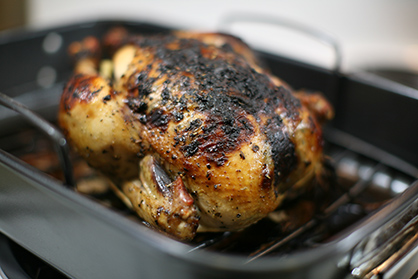
Chef's notes:
You may be wondering why exactly I am writing a recipe/article about baked chicken. You may also be saying to yourself, “but baking is what we do to bread, not meat”. And you would be right. But I already wrote an article using the “R” word (rhymes with toast). And I need to have all my bases covered. So therefore – “Baked” Chicken, had to be written. You may also be wondering what in the “H” I am talking about right now. If’n that’s the case, this article’s for you.
Ingredients
- 1 roasting chicken
- 6 Tbsp butter
- 1 Tbsp Herbes de Provence
- 5 Tbsp lime juice
- 1 Tbsp salt
- 2 tsp black pepper
Baked Chicken Recipe with Provencal Herbs, Butter, Salt, and Lime
- Clean the chicken and preheat the oven to 500 degrees F. For this article I am using a pastured chicken I picked up at the farmers market. Pastured means that the chicken lived outside in a pasture for part of its life—roughly the last half. Chickens live very short lives, but at least part of it was spent outside and not cooped up in a little cage. This chicken is also free of hormones and antibiotics. Give it a quick rinse under cool running water. Then pat it dry with disposable paper towels.
- Rub the chicken inside and out with herbs and spices. The rub I am using here is a mixture of melted butter, lime juice, salt, black pepper, and Herbes de Provence. Use your fingers to lift up the skin from the meat. Then brush the seasoning thoroughly throughout the whole chicken. If you are really tricky, you can even get the flavorings under the skin by the legs. Also, don’t forget about the neck cavity and the inside of the bird itself.
- Truss the bird and put in the middle of a roasting pan. Trussing is a way of tying the bird together with butcher’s twine. Professionals use a large needle called a trussing needle to sew the bird’s limbs to the body. But no fear; you don’t need to go buy a trussing needle. Just tie the legs together and tuck the wings underneath. Don’t worry if you don’t feel like trussing your chicken, as it is not required. It just looks better. Put the chicken in the oven on the bottom rack and set the timer for 20 minutes.
- After 20 minutes, check the chicken. Remove the pan from the oven and loosely cover the chicken with aluminum foil. Reduce the oven heat to 350 degrees F. If you have a digital thermometer with a detachable probe, stick that in the thickest part of the breast meat. Set the temperature alarm for 161 degrees F and put the bird back in the oven. If you don’t have the fancy thermometer, set the timer for 45 minutes. After the time is up, check the internal temperature. You are looking for a final temp of 161.
Tips & Tricks
- Let the baked chicken rest lightly covered with an aluminum foil tent for 15‒20 minutes before you carve it. Cutting too early will result in drying out your chicken.
- Stuffing the chicken will increase the cooking time, which may dry out the meat.
- Save the bones and skin for making chicken stock later. Just pop them in a bag and throw them in the freezer.
- A digital thermometer with a detachable probe is the best way to roast meat. You don’t have to open the oven to know what temperature the inside of the meat is. And when the target temperature is reached, it will tell you.
- Don’t forget to make gravy out of the drippings in the bottom of the pan.
Herbes De Provence Recipe
- 1 tsp thyme
- 1 tsp savory
- 1 tsp lavender
- 1 tsp tarragon
- 1 tsp marjoram
- 1 tsp oregano
- 1 tsp fennel
- 1 tsp sage (optional)
- 1 tsp basil (optional)
- 1 tsp rosemary (optional)
